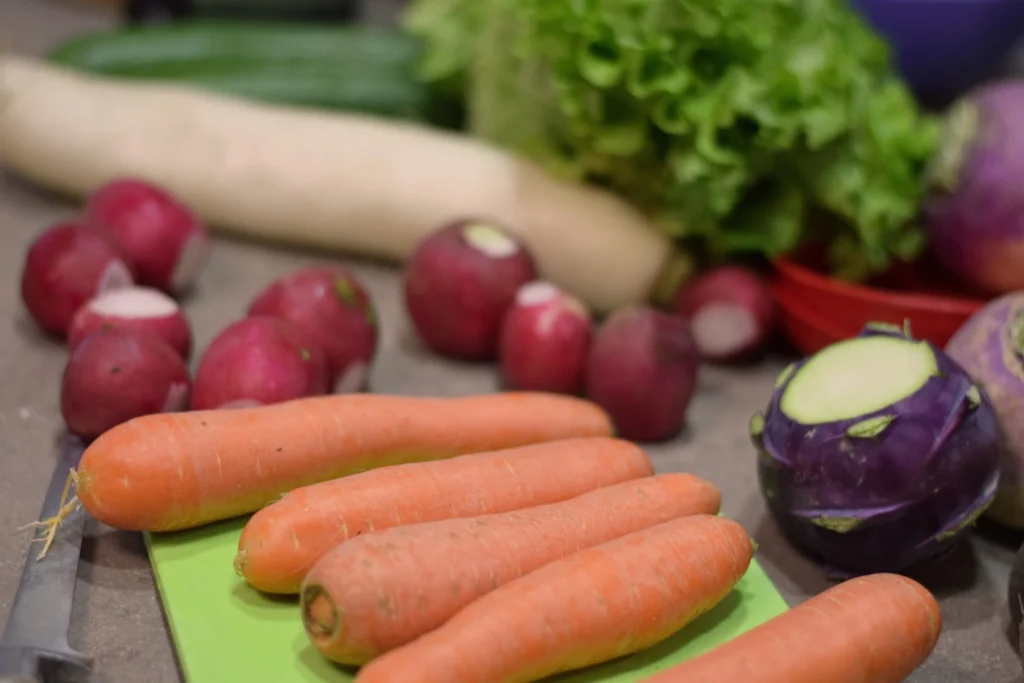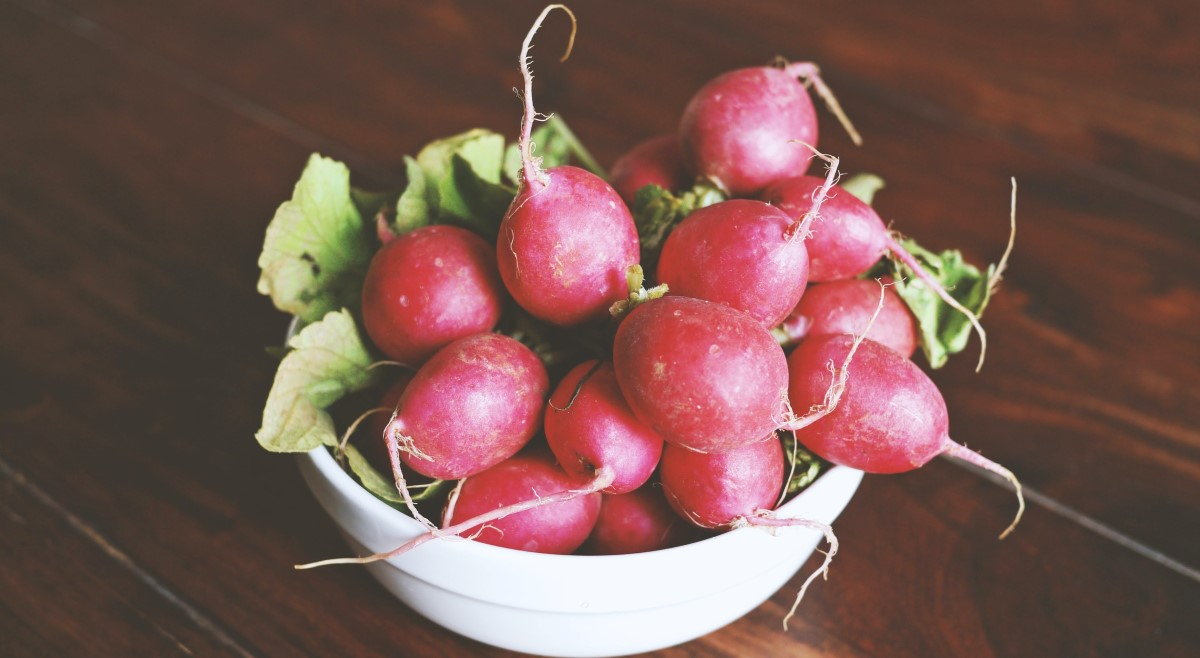Wondering if radishes are compatible with a low-carb diet? If you’re adhering to a keto or low-carb diet regimen, this question is likely on your mind. The great news is that radishes are indeed low in carbs and can seamlessly integrate into your dietary preferences.
In fact, one medium-sized radish contains just 0.2 grams of total carbs, making them a great addition to your low-carb or keto diet. Not only are they low in carbs, but radishes also offer various health benefits due to their high water content and essential nutrients. So, you can enjoy them guilt-free, knowing they won’t sabotage your dietary goals.
Radishes in low carb diet
First of all, let’s talk about carbs. A 100-gram serving of radishes contains only 3.4 grams of carbs, with 1.6 grams of fiber, making the net carb count just 1.8 grams. This makes radishes low carb, especially for those following a ketogenic diet.
In addition to being low in carbs, radishes are also low in calories. A 100-gram serving of radishes contains only 16 calories, making them a great option for those looking to lose weight.
Radishes are also a good source of vitamins C and K, as well as potassium and folate. They are also high in antioxidants, which can help protect against inflammation and disease.
The glycemic index of radishes is low, meaning they have a minimal impact on blood sugar levels. This makes them a suitable option for people with diabetes who need to monitor and regulate their blood sugar levels.
Summary of Macronutrient Content
Radishes come packed with macronutrients that are ideal for a ketogenic lifestyle. According to US Department 100g raw radishes contain the following ingredients:
Types of Radishes
To better understand radishes, let’s explore their types, health benefits, and taste and texture.
Radishes come in various shapes, sizes, and colors, but the most common types are red radishes and daikon. Red radishes are small and round with bright red skin, while daikon is a larger, elongated radish with white or light green skin. Both of these radishes belong to the cruciferous vegetable family, which also includes cabbage, broccoli, and cauliflower.

Taste and Texture of Radishes
The taste and texture of radishes can vary depending on the type, but they generally have a spicy, peppery flavor. Red radishes have a more pungent taste compared to the milder daikon. The texture of radishes is crisp and crunchy, making them a refreshing addition to salads, sandwiches, or even as a standalone snack. They can also be cooked or pickled to offer a different flavor profile and to incorporate into a variety of dishes.
By knowing the different types of radishes, their health benefits, and their unique taste and texture, you can confidently decide whether to include this low-carb root vegetable in your diet.
Radishes Vs Root Vegetables

When it comes to root vegetables, radishes have a lower carb count than many of their counterparts. For instance, a 100-gram serving of raw radishes contains approximately 3.4 grams of carbohydrates, while a similar serving of potatoes has around 17 grams. Turnips and parsnips have higher carb counts as well, with 8 grams and 18 grams per 100 grams, respectively.
In comparison to other low-carb root vegetables, radishes are on par with daikon radish, which has about 4.1 grams of carbs per 100-gram serving. However, radishes may still have more carbs than cauliflower (5 grams per 100 grams) and broccoli (7 grams per 100 grams).
Wondering if turnips are low carb? Then have a look at my article about the delicious keto root.
Radishes low carb diet integration
A low carb diet is a diet that limits carbohydrate intake and emphasizes protein and fat. The amount of carbs allowed on a low carb diet varies, but typically, it is less than 100 grams per day. A very low carb diet, such as the keto diet, limits carbs to less than 50 grams per day.
Radishes in Salad Vs Whole
When used in salads, radishes can be further compared to other low-carb vegetables. Here is a brief comparison of carb counts per 100-gram serving for various salad ingredients:
- Cucumber: 3.6 grams
- Zucchini: 3.1 grams
- Spinach: 3.6 grams
- Celery: 1.4 grams
- Cabbage: 5.0 grams
- Mushrooms: 3.3 grams
- Lettuce: 2.9 grams
As you can see, radishes have a similar carb count to most other low-carb vegetables typically found in salads. This makes them a suitable addition to your salad without significantly increasing the overall carb content. Just be mindful of the serving size, as consuming a whole radish may provide more carbs than you would typically include in a single serving of salad.
Recipe Ideas with Radishes
When it comes to incorporating radishes into your low carb diet, there are plenty of options. Radishes are versatile and can be used in various low-carb dishes. Here are some recipe ideas:
- Salad: Toss fresh, sliced radishes and use them as a crunchy low carb salad topping for extra flavor. You can also use them in combination with edamame, for most your salads.
- Fried Radishes: Substitute radishes for turnips or potatoes in breakfast recipes like skillet hashes with bacon. It’s also a good addition to your Low Carb Canned Chicken Recipes
- Roasted Radishes: Combine radishes with butter, olive oil, and garlic for a tasty side dish.
- Pickled Radishes: Create your own pickled radishes to spice up sandwiches and salads or as a garnish to main dishes.

I highly recommend tasting some fried radishes as a wonderful potato replacement and you will never regret sticking to your low-carb diet.
Remember, there are many more radishes low carb recipes available to explore! Don’t be afraid to get creative.
Overall, radishes low carb are a great vegetable option that can add flavor and variety to your meals while still keeping your carb count low.
Tips for Cooking Radishes
When cooking radishes, keep these tips in mind:
- Enhance their flavor by combining them with complementary ingredients like butter, olive oil, garlic, mustard, and horseradish.
- Preheat your oven when roasting radishes to ensure they cook evenly.
- For oven-roasted radishes, aim for a golden brown, slightly crisp exterior while retaining a tender interior.
Experiment with different seasonings to find your favorite taste and texture of radishes low carb recipes.
Storing and Freezing Radishes
Proper storage and freezing of radishes low carb can help you reduce waste and make the most of your leftovers. Follow these guidelines:
- Store fresh radishes in the refrigerator, with their green tops removed, in a plastic bag or container.
- When freezing radishes, blanch them first, then transfer them to a freezer-safe container or bag.
- Keep in mind that freezing radishes may alter their texture but can still be used in cooked dishes like soups, stews, or casseroles.
With these tips and recipe ideas in mind, you can easily incorporate radishes into your low-carb diet. Enjoy their unique flavor and crunchy texture while staying on track with your healthy eating goals.
Frequently Asked Questions
Can you eat radishes on keto?
Yes, radishes are a low-carb vegetable and can be consumed on a keto diet. They are a great option for those following a ketogenic diet as they contain only about 3 grams of net carbs per cup and are a good source of vitamin C, fiber, and other important nutrients.
Do radishes spike insulin?
No, radishes do not spike insulin levels as they have a low glycemic index and are low in carbohydrates. They are a great option for those following a low-carb or ketogenic diet as they do not cause a rapid increase in blood sugar levels.
What should you avoid eating radishes?
You should avoid eating radishes if you have an allergy to them. Additionally, if you have a history of kidney stones, you should limit your intake of radishes as they contain oxalates, which can contribute to the formation of kidney stones.
Are air-fried radishes low carb?
Air-fried radishes can be keto-friendly, depending on the type of oil and breading used. It’s essential to choose a low-carb, keto-friendly breading and cooking oil to keep your air-fried radishes within the keto-friendly range.
If you liked this blog article about the topic: Are Radishes Low Carb, don’t forget to leave us a comment down below to tell us about your experience. And don’t forget to follow us on Pinterest so you don’t miss any more Diet and Nutrition news.

